Thursday, March 17th, 2011...3:20 pm
Pour Jam Sugar on Me
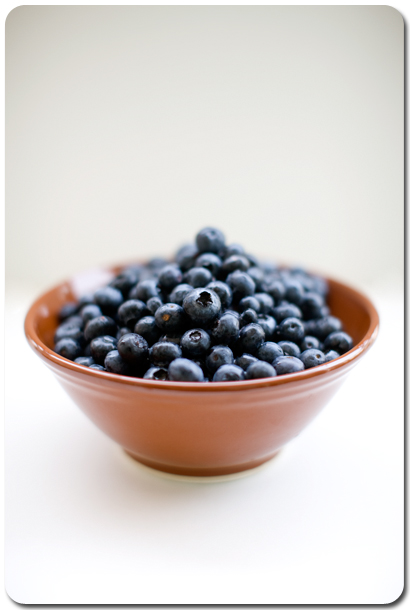
A couple of months ago, D – a good friend of mine – suddenly turned to me whilst we were having drinks, and declared that she wanted to make blueberry jam. I was delighted to hear this, having assumed she meant she was going to make some and gift me with a bottle or two. :P Sadly, what she really meant was that she wanted to learn how to make jam (specifically, blueberry), and was hoping for a lesson. Naturally, I obliged.
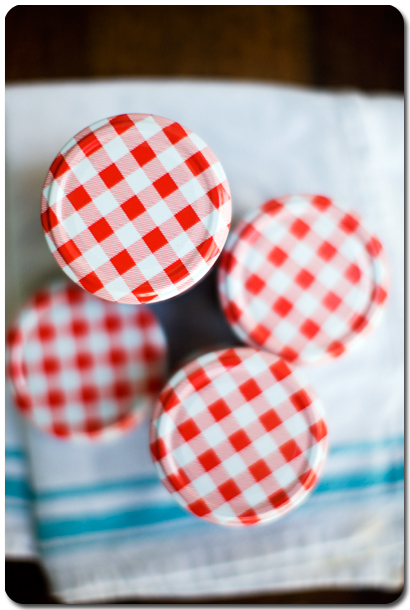
Blueberries are a soft, sweet, and not especially acidic fruit that generally contains about 0.4% concentration of pectin at most. This means that when making jam, you will most likely need to add additional acid and pectin to the fruit in order to get a firm set, as you generally need about 1% pectin in your jam, and a pH level of around 2.8-3.6 for the jam to set.
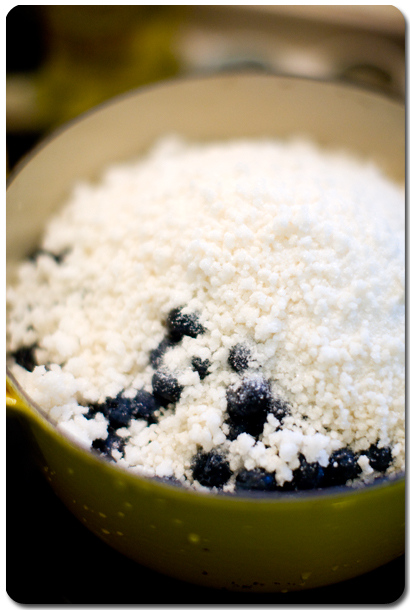
I had a sniff around a couple of supermarkets here in Hong Kong, and for some reason, couldn’t find any plain pectin, but I did find a bag of jam sugar – which is sugar that has pectin already added to it. (Jam sugar normally also contains some added citric acid in order to allow the jam to set.) As you can see in the picture above, the appearance of jam sugar is kinda clumpy – this is to be expected, thanks to the additives.
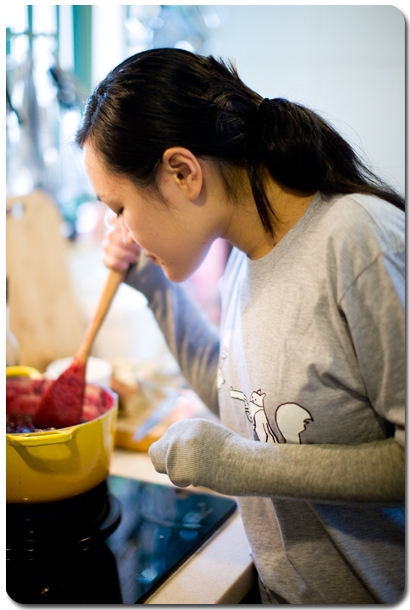
Now, one benefit of using jam sugar over extracting your own pectin (or cooking a jam without any added pectin), is that you only need to bring the mixture to a rolling boil for between 1-4 minutes (depending on your brand of pectin – just follow the manufacturer’s instructions for timing), and you’ll be able to achieve your firm set. This translates to a jam that generally will retain brighter colours and flavours, as the amount of time you need to cook the jam for is greatly reduced. (Some say it also retains more nutrients in the fruit since it’s not cooked to hell and back – anybody know if it’s true?)
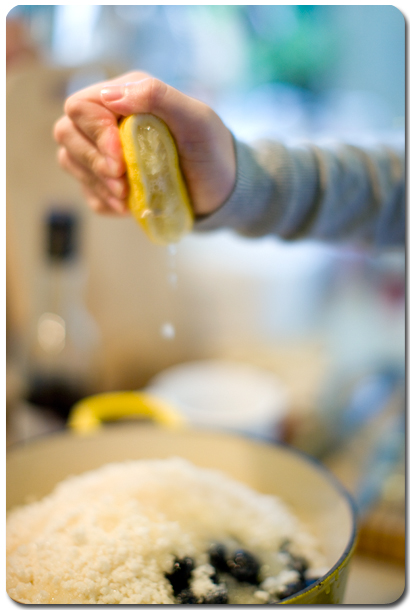
Nutritional content aside though, when making jam, it’s always important to taste some of the fruit you’re preserving before you start. Like all cooking, the flavour of your final product is very much contingent on the raw ingredients you start with. For example, the blueberries we used were fairly sweet, but not very acidic, so I decided to add in the juice of two lemons, and used a ratio of about 3:5 for sugar to fruit (by weight).
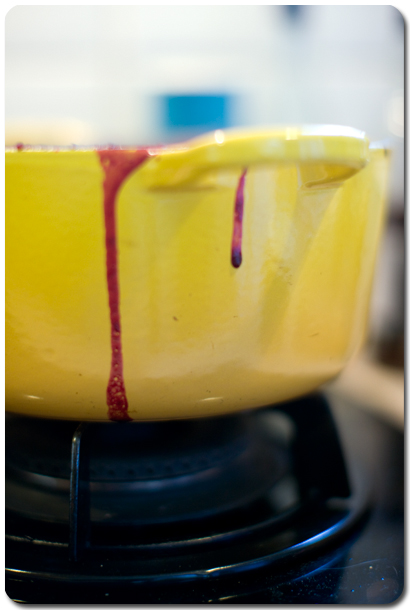
Anyway, she’s probably going to kill me for putting up this picture, but I really couldn’t resist. :) Hopefully, this post (this picture?) will inspire you to get jamming too – it probably took about 15 minutes of weighing, measuring, juicing, and stirring before D was delightedly peering into that steaming pot of jam. And in case you needed a little more convincing with regards to commercial pectin, all I can say is this: the faster the jam sets, the faster you’ll be on your way to making out with a sticky ladle too. ;P

Blueberry Jam
1kg fresh blueberries
600g jam sugar (I used this one)
juice of 1-3 lemons
20g unsalted butter
Wash and drain the blueberries. Tip them all into a large, heavy-based pot set over medium heat. Add in the sugar and lemon juice.
Stir the mixture, crushing the blueberries as you go, with a wooden spoon, and as it heats up, until the sugar has dissolved in the blueberries and its juice. Moderate the heat and do not allow the mixture to come to a boil until the sugar is completely dissolved. Have a taste, and adjust the sweetness and/or acidity, if necessary.
Once the sugar has dissolved, add in the butter, stir it in, and turn the heat up. Let the pot come to a rolling boil (that doesn’t go away with stirring). When it boils, let it cook, stirring occasionally, for 4 minutes (or as long as the manufacturer of your jam sugar instructs). Ladle or pour the jam into warm, sterilized jars, screw on the lids and place in a deep pot of boiling water. The jars should be submerged by at least an inch. Boil rapidly for 10 minutes, then remove from the heat, dry off the bottles and allow to cool to room temperature in a cool, draught-free place. With their seals intact, bottles of jam will keep in a cool, dark place for about a year. (Once open, keep refrigerated and consume within 4 weeks.)
Alternatively, store the jam in clean containers in the fridge for up to 4 weeks.
Yield: About 1.5L of jam
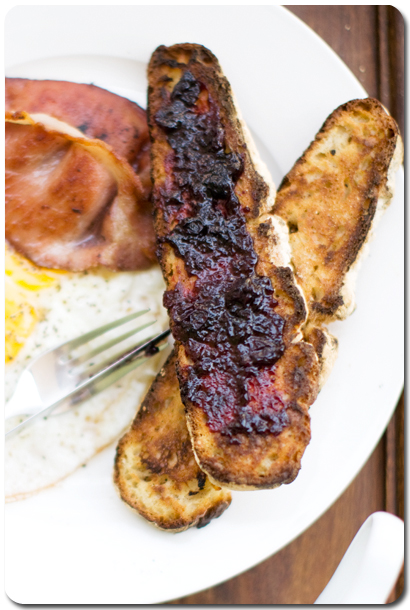

4 Comments
March 17th, 2011 at 6:38 pm
completely irrelevant but I have the same t-shirt as D !!! lol.
March 22nd, 2011 at 1:19 pm
Jam sugar?! Never heard of it–but now I need to find it!
March 24th, 2011 at 8:54 am
wl: haha it’s super cute, threadless teeshirts ftw right? :)
Sarah: well, if you can’t find jam sugar, it’s no big either – just use sugar + commercial pectin?
April 23rd, 2011 at 4:08 am
Hi,
I was wondering if you’d know where I can buy Pectin NH, it’s used for making clear glaze for cakes. I’d really like to buy some in Hong Kong if possible when I go visit next month. I’m trying to reduce the weight of stuff I can bring back to Canada with me, really. I know I can buy mirror glaze already made, but, I’d rather just have Pectin NH is possible. If you could help me with this, that would be great since I don’t really know what they’d call it in Chinese. Thanks!